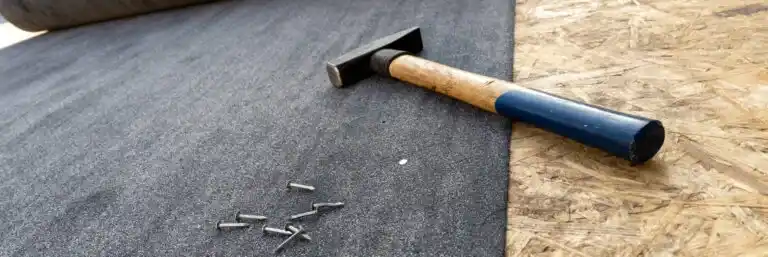Have you ever needed a backup plan? It’s always wise to cover your bases in case your first plan falls through.
Our roofs also have backup plans in the form of underlayment. If for any reason, the shingles or other roofing materials get damaged, roofing underlayment is an extra line of defense against water damage.
Let’s take a look at:
- What is roof underlayment?
- The differences between the types of underlayment
WHAT IS ROOF UNDERLAYMENT?

Roofing underlayment is the material between the shingles and the plywood roof deck. It gets installed directly on top of the roof deck in order to provide an additional layer of protection against:
- Snow ❄️
- Rain 🌧️
- Wind 🌬️
- Extreme heat 🥵
Underlayment should get installed across the entire surface of your roof decking. Additionally, it’s recommended for a waterproof underlayment to be added in the following areas that are prone to water collection and ice dams:
- Valleys
- Eaves
- Chimneys
- Vent pipes
- Skylights
Roof underlayment is an incredibly important component of a complete roofing system that helps keep your home dry. Trust us; you don’t want water damage in your home. It’s an expensive and tedious issue to fix, so always opt to stop the problem at the source by opting for a professional roof installation.
THE 3 MAIN TYPES OF ROOF UNDERLAYMENT
You have options when it comes to choosing the type of underlayment you want for your roof. Historically, roofing felt has been the most popular choice for underlayment, but in recent years, synthetic and rubberized asphalt underlayments have been been on the come up.
Let’s take a closer look at the pros and cons of all three options.
1) FELT UNDERLAYMENT
Felt roofing underlayment is made by saturating a fiberglass mat with asphalt. It’s one of the oldest and most commonly used types of underlayment in the industry. You can find roofing felt in No. 15 felt or No. 30 felt, with No. 30 being the stronger and thicker option.
✅ Felt Underlayment Pros
- Affordable cost
- Easily accessible
- Easy to install
❌ Felt Underlayment Cons
- More prone to tearing
- Weighs more
- Can wrinkle if exposed to moisture
- Less material per roll, leading to more seams

2) SYNTHETIC UNDERLAYMENT
Even though roofing felt has been the go-to choice for many years, there’s a newer product that’s been in the spotlight lately. Synthetic underlayment is made from durable polymers that are actually melted-down recyclable materials. It’s now the preferred underlayment type of most modern roofing contractors.
Different roofing manufacturers usually make their synthetic materials different from one another, so be sure to do your research on the most high-performing brand.
✅ Synthetic Underlayment Pros
- More durable than felt
- Quick and safe to install
- Repels water effectively
- Can handle UV exposure during the installation process
- Lightweight
- Resistant to mold growth
- Easy for roofers to walk on during installation
❌ Synthetic Underlayment Cons
- Higher upfront cost
3) RUBBERIZED ASPHALT UNDERLAYMENT
Rubberized asphalt roofing underlayment is made from— you guessed it— rubber and asphalt. Rubberized asphalt is a peel-and-stick material like the other types of underlayments. The sticky, rubbery material allows it to form around nails and staples without causing punctures.
✅ Rubberized Asphalt Underlayment Pros
- Only fully waterproof underlayment
- Easy to install
- Lasts up to 50 years
- Resistant to UV rays
- Easy to repair
- Won’t wear down when roofers walk on it
- Excellent for humid regions and areas with intense winters
❌ Rubberized Asphalt Underlayment Cons
- Highest upfront cost of the three options
- Not all brands are fire-resistant
HOW TO CHOOSE THE RIGHT UNDERLAYMENT FOR YOUR ROOF
Any of these three options will help keep your roof protected against water damage. However, you can decide which underlayment you want based on your:
- Climate
- Roofing material
- Budget
For example, metal roofs can trap more heat, so they do best with synthetic underlayment. If you live in a temperate, mild climate, felt underlayment will serve you well. But if you live in a particularly humid region, you may opt for the extra waterproofing that comes with rubberized asphalt.
Ultimately, have a conversation with your roofing contractor. Feel free to ask them about the options you have and what they recommend. Some roofing companies may have exclusive partnerships with certain manufacturers, while others can install any manufacturer of your choosing. When it comes to an investment as significant as your roof, you deserve to be informed and educated!
GET A TOTAL ROOFING SYSTEM YOU CAN COUNT ON
It’s clear that roofing underlayment is an incredibly vital aspect of a functioning roofing system. To ensure you get a high-quality roofing system when you replace your roof, opt to hire a professional roofing company with many years of experience.
Here at Mars Restoration, we work with the best manufacturers in the roofing industry, and we take the time to educate you on all your options so that you can make an informed decision about your home and finances.
Reach out to Mars today for a free inspection!



